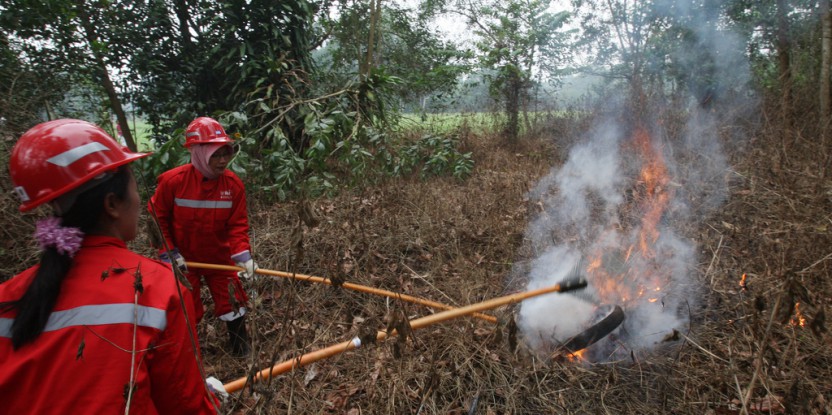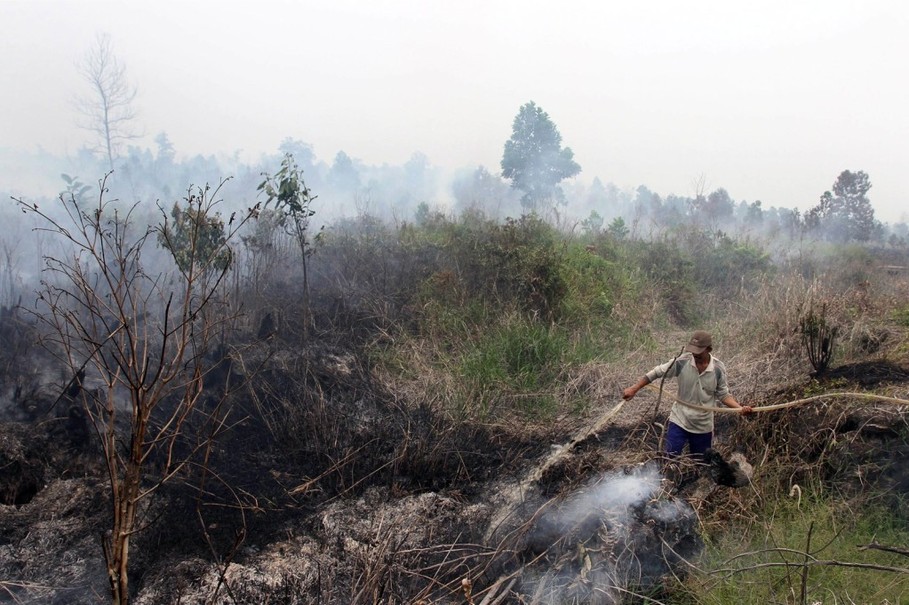
Editor’s Note: The haze crisis will be a key theme of discussion at the upcoming Forests Asia Summit, 5-6 May in Jakarta, Indonesia. At the Summit, a workshop will examine the underlying causes and impacts of peat land fires, focusing on the role of conflicts over land ownership between communities and companies; impacts on human health; and the transboundary bill recently proposed by the Singaporean government. Read more here.
JAKARTA, Indonesia — Peatland fires in eastern Sumatra, Indonesia, in recent weeks are again creating thick haze in the region, closing schools, canceling flights, and leading to the arrests of farmers accused of lighting the fires.
For now, the weather is keeping the smoke away from neighboring Singapore and Malaysia, where in June 2013 wind-blown haze from Sumatran fires caused record-high levels of air pollution. Last year’s crisis produced international headlines and quick responses from governments: High-level regional talks in September led to a proposed transboundary haze monitoring system, and earlier this month, Singapore drafted a bill that would allow it to fine companies for fires that take place on Sumatran plantations. The return of fires this month, however, has illustrated the need for long-term, holistic solutions to the haze issue.
To that end, a workshop held in January in Jakarta was the first major step toward a research program to better understand the drivers of the fires, to spur greater collaboration among Indonesian and regional stakeholders at all levels, and to untie the knot of policies and regulations that govern land use and fire protection in Indonesia. The workshop, hosted by the Center for International Forestry Research (CIFOR), drew more than 50 people — including researchers, government officials, and leaders from communities, civil society and the private sector, among others. CIFOR has extensively studied fires in Indonesia’s tropical forests, in particular the 1997 crisis and the 2013 fires.
“The situation is much more complex than the media portrayed, when there was a very high focus on the ‘hotspots,’ which are important, but crude, indications from space,” Peter Holmgren, CIFOR’s director general, told the audience. “We need to document the full extent of issues on the ground, better understand how priorities are set and decisions made, and then actively share information and knowledge.”
The meeting illuminated just how complex the situation is in the ground.
There was widespread agreement on several issues — chief among them, that the fires that caused the haze last year were not forest fires. Set deliberately to clear peatlands and deforested areas for agriculture, the fires “were caused by people,” affirmed Daniel Murdiyarso, a CIFOR principal scientist, at the workshop’s first session.
As the day went on, however, the workshop laid bare a wide divergence of perceptions among the participants about who was responsible for starting the fires and who was responsible for putting them out; about which agency had jurisdiction over the fires, and which laws applied; about why the fires caused so much haze; and even about who suffered the greatest impacts. From numerous presentations and breakout discussions, though, a consensus started to coalesce around the need for stronger governance, better monitoring and more research.
‘The main problem’
More than a few presentations at the workshop hammered on two key themes: overlapping claims over land ownership, and contradictory land and fire regulations. Land use, land tenure and firefighting in Sumatra are governed by a tangle of national, provincial and customary laws. This situation, participants explained, is exacerbated by an influx of land-seeking migrants; investments in agricultural expansion by companies; and tensions among small-scale agriculturists, mid-level planters and investors, and plantation companies. A lack of coordination among different levels of government; inadequate monitoring; and insufficient capacity in law enforcement and firefighting render governance woefully ineffective.
“Governance,” said one participant, “is the main problem [behind] everything.”
In a presentation to the workshop, another participant explained that at least eight national regulations govern fires and disasters, including the fires of June 2013; many of the regulations are in conflict with each other, he said. The speaker, a senior government official, said that local governments have no standard procedures for fighting fires — and in any case are more concerned about fires in buildings than on lands. “No one is reminding local governments,” he said, “that [land] fires are under their jurisdiction.”
With respect to land-use governance, the official said, conservation forests are the authority of the central government — but plantations (like oil palm) and peatlands have been under the authority of local governments, causing further confusion. Legal loopholes enable local governments to grant plantations on production forests controlled by the central government, while land-seeking migrants occupy such lands illegally but with the backing of the local elite. Customary law, then, is in conflict with provincial and national laws over land ownership.
This scenario promotes uncertainty over land tenure, said the head of an indigenous community group in Riau province, where most of the June 2013 fires burned. This has led, he said, to forested landscapes controlled by the central government in Sumatra being seen increasingly as a source of income to exploit, fueling an influx of migrant communities and agro-industrial businesses into Riau to compete for land in these areas. This influx pushes aside local people — and the traditional knowledge that they employ to clear land by fire without allowing the fires to spread.
“Fire and haze are consequences of this battle,” the community leader said.
Another participant, representing a forestry corporation, disagreed with statements that placed blame on large-scale plantation owners, saying that fires on his company’s properties were not only against its longstanding “no-burn” policy, but that they represented a major threat to its assets. “We act fast to detect and extinguish fires in our concessions and near our concessions,” he said. When fires occur on company concessions, he said, “We are the victims.”
Gaps in research
David Gaveau, a CIFOR scientist who presented research at the workshop, began mapping overlapping claims over land ownership using satellite technology and maps of concession boundaries obtained from the central and provincial governments. His work showed that more than half of the area that burned in June 2013 lay within concession areas allocated for industrial oil palm or acacia plantations — but that 60 percent of this land was occupied by smallholders. Smallholders say that the land they occupy in the concessions belongs to them.
The data, however, don’t explain who started fires, Gaveau said, but field investigations confirm the occurrence of fires used in conflicts among small agriculturalists and companies. It does not make business sense, he said, for companies to burn their productive plantations, although historical satellite records suggest that companies have used fire to convert forest lands to plantations in 2005. Gaveau said that it is fair to conclude that both companies and small agriculturalists have used fire at one point in time during the land conversion process to agriculture.
These issues, said Louis Verchot, director of forests and environment at CIFOR, are just part of the puzzle that research can help assemble. A broad research program on the haze issue, he told the workshop, would seek to contribute to a reduction in fires, carbon emissions and haze through a better understanding of the socioeconomic drivers of fires; of the fires’ impacts on climate and human health; and of the challenges of and opportunities for improving governance.
The next step in a proposed haze research program will come into focus in the coming months and is among the topics to be discussed at the Forests Asia Summit, 5-6 May — just as Sumatra’s dry season begins.
For more information about this issue, please contact CIFOR scientist David Gaveau at d.gaveau@cgiar.org
We want you to share Forests News content, which is licensed under Creative Commons Attribution-NonCommercial-ShareAlike 4.0 International (CC BY-NC-SA 4.0). This means you are free to redistribute our material for non-commercial purposes. All we ask is that you give Forests News appropriate credit and link to the original Forests News content, indicate if changes were made, and distribute your contributions under the same Creative Commons license. You must notify Forests News if you repost, reprint or reuse our materials by contacting forestsnews@cifor-icraf.org.
